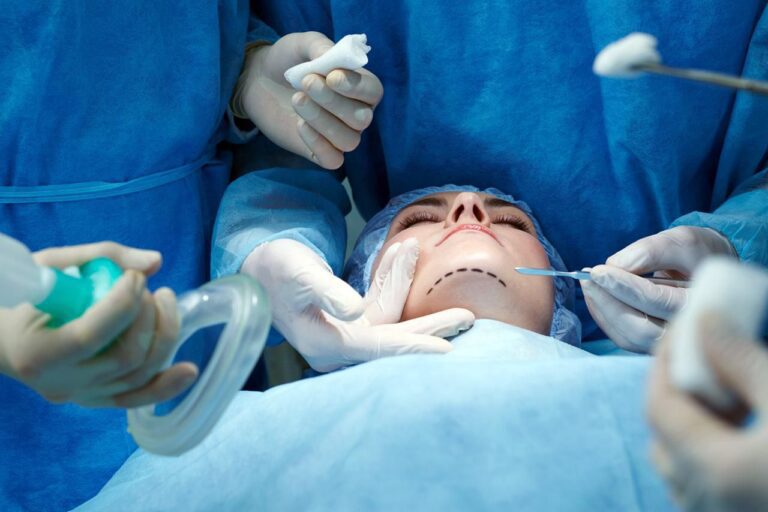Although rare, nerve damage is a serious complication that anyone considering plastic surgery should be aware of. Whenever an incision is made in the skin, there is a chance that the nerves will be affected.
Minor nerve injuries usually heal on their own over time and become barely noticeable. However, severe nerve damage that occurs after plastic surgery can be devastating.
While surgical nerve damage is not always avoidable, it is particularly devastating in plastic surgery because the procedures are elective as opposed to medically necessary. This article discusses the types of nerve damage that can occur with plastic surgery, as well as treatment options that can help.
Causes and consequences of nerve damage
Nerve damage can occur with any plastic surgery procedure. Injury occurs if nerves are stretched, cut, or cauterized. Damage from injections is also possible.
It may be normal to feel pain or abnormal sensations in the skin for a period of time after surgery. However, symptoms that persist for three months may indicate nerve injury.
Nerve damage can present with a range of sensory symptoms, including:
- Numbness
- Tingling
- Burning or shooting pain
- Hypersensitivity
Certain types of nerve damage can also lead to motor nerve deficits, including:
- Weakness
- Paralysis of certain muscles
If a nerve is severely damaged, the effects can be permanent.
Complication rates
Any type of surgery can result in nerve damage. However, the risk of nerve injury often depends on the type of surgery performed.
A 2023 review posted on Frontiers in Neurology reported the following rates of nerve complications after plastic surgery:
- Blepharoplasty (blepharoplasty): Supraorbital nerve or supratrochlear nerve (4.0%), infraorbital nerve (2.8%)
- Rhinoplasty (nose surgery): olfactory dysfunction (31.8%)
- Rhytidectomy (face-lift): Facial nerve injury (1.0%), permanent nerve injury (0.03%)
- Breast surgery: Intercostal cutaneous nerve (8.86-10.01%), long thoracic nerve (0.01%), permanent nerve damage (1.66%)
- Abdominoplasty (“tummy tuck”): Lateral femoral cutaneous nerve (1.36%), iliohypogastric nerve (0.1%), permanent nerve damage (1.02%)
Even when your surgeon provides the “standard of care,” nerve injuries can occur.
Recovery from nerve damage
Most nerve damage will recover spontaneously (without treatment) within six months to a year. In some cases, it may take two to three years for full recovery.
As the nerve heals, you may experience itching, pain, or electric shock sensations. However, these symptoms are usually temporary and are often a sign that the nerves are returning to normal function.
That said, the following are treatment options that may help with nerve damage recovery.
Conservative Management
Conservative treatment options include:
- Watchful waiting: If nerve damage is suspected, watchful waiting is usually recommended to see if the nerve has the ability to heal on its own.
- Oral medicine: Analgesics, tricyclic antidepressants, and anticonvulsants may be used to help relieve pain caused by injured nerves.
- Nerve Blocks: This procedure involves injecting numbing medicine near specific nerves to help block pain from certain parts of the body.
- Steroid therapy: Corticosteroid injections may be used to help relieve pain.
Surgical Treatment
If a nerve is severely damaged, it may not have the ability to heal itself. For example, if the nerve is severed, then the numbness and inability to move the affected muscle is permanent. Surgery is required to restore function in such cases.
Surgical treatment options include:
- Immediate Nerve Repair: This procedure involves sewing or gluing the ends of the nerves together. This is often done when a nerve is suddenly cut in half.
- Nerve Transplantation: A nerve graft (nerve tissue from another part of the body) is used to fill the gap between the ends of a damaged nerve.
- Nerve conduction: This surgery involves connecting the ends of a damaged nerve using a healthy donor nerve from another part of the body.
Nerve damage by procedure
Certain procedures have certain effects if a nerve is damaged. The tables below summarize which nerve injuries are associated with certain plastic surgery procedures.
| FACE ENHANCEMENT | |
|---|---|
| Procedure | Effect of nerve damage |
| Forehead/eyebrow lift | Loss of movement or weakness of the muscles of the forehead Loss of sensation in the skin of the eyelids, forehead and scalp Inability to close the eyes |
| Rhinoplasty (nose job) | Numbness of the nasal skin |
| Rhytidectomy (facelift) | Numbness of the face Inability to move the face and express the face (eg smile) Drooping of the cheek, mouth or lips Numbness of parts of the ear |
| Genioplasty (chin augmentation) | Numbness, pain and tingling of the lips, chin and cheeks Drooping of the lower lip |
| Neck lift | Numbness of parts of the ear Drooping of the mouth or lips Numbness of the skin of the throat |
| BREAST SURGERY | |
|---|---|
| Procedure | Effect of nerve damage |
| Breast enlargement | Increased or decreased nipple sensation Numbness near the incision Numbness of the skin of the breast |
| Mastopexia (breast lift) | Loss of nipple sensation Numbness near incisions Numbness of the skin of the breast |
| Breast reduction | Loss of nipple sensation Numbness near incisions Numbness of the skin of the breast |
| BODY OUTLINE | |
|---|---|
| Procedure | Effect of nerve damage |
| Abdominal pressure | Numbness and tingling of the skin of the abdomen |
| Liposuction | Numbness at the incision sites Numbness and tingling in liposuction areas |


